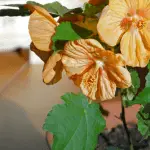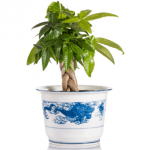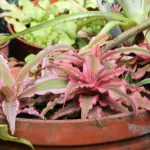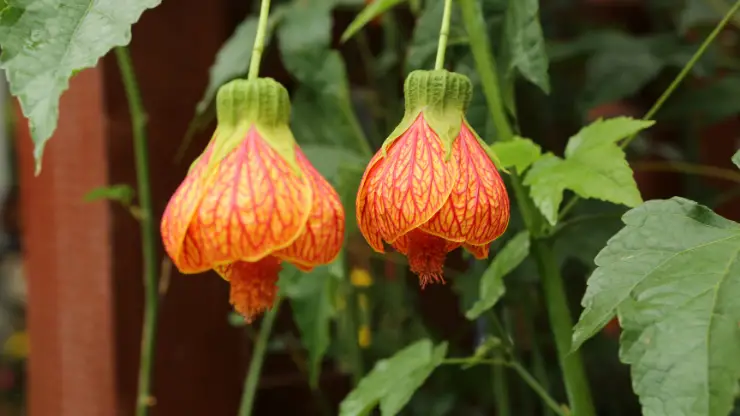
Abutilon is called “flowering maple” because of its broad, five-lobed leaves that look very similar to maple leaves. However, this plant is not a true maple. In fact, it’s more closely related to hollyhock. Other names for this plant include Chinese lantern, parlor maple, and Indian mallow.
When given proper care, flowering maple will reward you with drooping, papery flowers that appear almost year-round. The long, twiggy stems bend and arch under their weight, and the entire plant reaches heights of up to 4 feet (1.2 meters). Flowers may be red, orange, yellow, pink, white, or peach-colored, depending on the variety.
Commonly grown outdoors, abutilon also makes a lovely flowering houseplant – if you have the patience to care for it.
Flowering Maple Houseplant Care
Unlike many other blooming houseplants, flowering maple is not hard to grow. I would consider it of moderate difficulty. If provided with enough bright light and good basic care, it will thrive in your home for many years. Here’s a basic rundown of care guidelines:
- WATER: When top 1 inch of soil feels dry
- HUMIDITY: Moderate in winter or dry climates
- FEEDING: Every two weeks spring – fall, once monthly in winter
- LIGHT: Bright, indirect
- TEMPERATURE: 65 – 75 degrees F (18 – 24 degrees C)
- SAFETY: Leaves may be toxic to humans and pets if ingested
- DIFFICULTY: Moderate
Keep reading for more detailed care instructions including maintenance tips, troubleshooting, propagation, and how to keep this plant looking its best for as long as possible.
Water
Water your flowering maple thoroughly, then don’t water again until the top 1 inch of soil feels dry to the touch. (Insert your finger into the soil up to the first knuckle. If the soil feels dry, it’s time to water. If it still feels moist, check again the next day.)
Humidity
Flowering maple does not need super high humidity levels. But, you should mist the plant once every few days during winter when indoor air is dry to prevent problems with spider mites. Use a spray bottle filled with lukewarm water set to the mist setting.
If you live in a dry climate, it may be beneficial to mist several times a week all year long. Additionally, consider placing the plant on a humidity tray or placing a high-quality houseplant humidifier in the room if you have dry air.
Fertilizer
Feed your flowering maple houseplant every two weeks with a balanced houseplant fertilizer during spring through fall. In winter, when growth has slowed down, reduce feeding to once a month. (Keep in mind if your potting mix includes fertilizer, you may not need to fertilize for the first six months or so.)
My favorite houseplant fertilizer for flowering plants is Jack’s Blossom Booster, but any all-purpose food will work. Read my review of Jack’s Fertilizer to see why I love it so much. I use the original formula, houseplant special, or blossom booster on all my plants (depending on their needs).

Light
Flowering maple houseplant needs bright, indirect light to thrive and produce flowers. Its ideal location is an east-facing window. If you don’t have a bright enough area, consider supplementing the natural light you do have with artificial lights. (I’ve recently started using this one for my houseplants and I love it!)
Although it can tolerate a few hours of direct sun each day, flowering maple performs best in the cool morning sun from an east-facing window. It does not do well in the heat and should be shielded from the hot afternoon sun. If you must place it in a west- or south-facing window, hang sheer curtains to filter the light.
Temperature
Average room temperatures of around 65 – 75 degrees F (18 – 24 degrees C) are perfect for flowering maple year-round. It does not like hot temperatures. Make sure to keep it away from blasts of heat from heating vents or wood stoves during the winter months.
Potting
Re-pot young flowering maple plants every six months or so to accommodate the fast-growing roots. Each time, move the plant to a pot with a diameter at least 4 inches (10 cm) larger than its current container. You can grow this plant in hanging pots or ground planters.
Use any high-quality potting soil formulated for houseplants. My favorite is this one by Happy Frog because it contains mycorrhizal fungi and beneficial soil microbes. Never amend the soil with lime, as flowering maple prefers acidic soil conditions.
Propagation
Unfortunately, flowering maple becomes woody and unattractive after about 3 – 4 years of being grown indoors. But you can keep a plant going indefinitely by propagating from stem cuttings. Just follow these steps:
- Cut a 4-inch (10-cm) piece of stem from a healthy area of the parent plant. Using pruning shears, make the cut at a 45-degree angle. (Early morning is the best time to take cuttings.)
- Remove leaves from the lower one-third to one-half of the cutting. Dip the cut end into a rooting hormone, which will help the plant produce roots faster. Tap to remove any excess if using a powder formula.
- Insert the bottom one-third to one-half of the cutting into moist seed starting potting mix.
- Cover with plastic and place in indirect light. Avoid direct sun. Keep the potting mix moist (but not wet), and transplant into regular potting soil after 4 – 6 weeks.
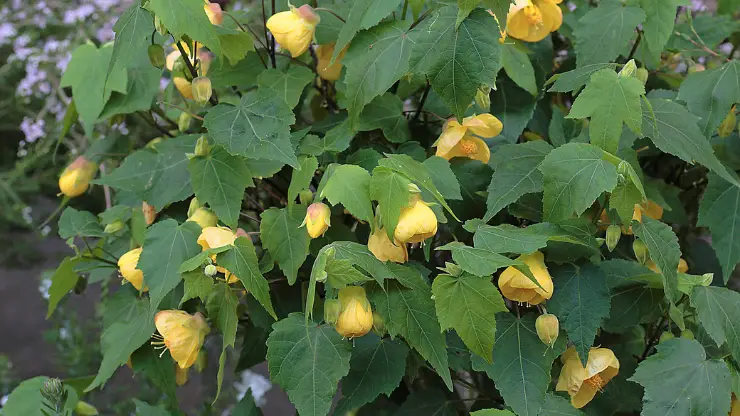
Maintenance
Flowering maple tends to become leggy, so it’s important to cut the plant back by one-third its size in early spring – just before the biggest flush of active growth begins. You can also pinch back long stems throughout the summer to encourage a bushier shape. Regular pruning makes it easy to keep abutilon a manageable size indoors.
In addition to growing in pots or hanging baskets, you can train your flowering maple houseplant into a more tree-like shape by tying the main stem to a stake and pinching off any branches that emerge from the lowest 15 inches (38 cm) of the stem.
Abutilon flowers are produced continuously all year long, but you’ll get more of them in spring and summer. In addition to being beautiful, they are also sweet and edible. If you snip them off before they wilt, you can use them in salads. (Do not eat the flowers if you’ve used any chemicals on the plant such as pesticides or non-organic fertilizers.)
Troubleshooting
Here are some common problems that indoor gardeners often have with growing flowering maple as a houseplant (and what to do about them).
- Plant Not Blooming – If your flowering maple does not bloom, that usually means it’s not receiving enough bright light. Move to a brighter location such as an east-facing window. This can also indicate it needs additional fertilizer. If you haven’t fed your plant in a while, apply a balanced houseplant fertilizer according to the package directions.
- Flowers and Leaves Drop – If the flowers and/or leaves are dropping off your flowering maple, this can indicate uneven watering or too much direct sun. Move to an area that does that does not receive hot, midday sun. And make sure when watering to pour water evenly around the pot so all the roots are saturated with water.
See my post Why is My Flowering Maple Wilting? if you’re experiencing leaf drop for more in-depth solutions to this issue.
Related Questions
Here are some commonly asked questions related to growing flowering maple houseplant that you might find useful (and my answers to them).
Can Flowering Maple Grow Indoors? Yes, absolutely. Although commonly known as an outdoor plant, flower maple can be successfully grown indoors as a houseplant. It will even produce flowers if given enough bright light and proper care.
How Big Does a Flowering Maple Get? Outdoors and in the wild, flowering maple can reach heights of up to 10 feet (3 meters). Indoors, however, they only reach about 4 feet (1.2 meters) in height at the most. And it’s possible to keep them much smaller with regular pruning.
How Do You Take Care of a Flowering Maple Tree? Place in a location that receives bright, indirect light but not direct sun, such as an east-facing window. Water any time the top 1 inch of soil dries out, feed every two weeks in spring through fall with a balanced fertilizer, mist regularly during winter months or when air is dry, re-pot every six months or so, and cut back to about 1/3 its size in spring to prevent leggy growth.
How Much Sun Does a Flowering Maple Need? This plant needs lots of bright, indirect light to produce flowers, but it cannot tolerate too much direct sun. The best location indoors is in an east-facing window. If you must place in a west- or south-facing window, filter the light with sheer curtains to prevent burning the leaves. North-facing windows will not provide enough light, but you can always supplement with artificial plant lights.

Where to Buy Flowering Maple Houseplant
If you’re lucky, you may find a flowering maple houseplant for sale at your local nursery or big box store with a garden center. I have never seen one, but you might call around and ask first. If you’re not able to find one locally, I recommend checking on Etsy for live plants.
I love buying my hard-to-find and exotic houseplants on Etsy. You can find so many different varieties and cultivars that you might not find locally. Plus, I like to support small growers. I find they typically have much higher quality plants than large online nurseries (since they have a reputation to uphold).
Click here to see the current listings for flowering maple houseplant on Etsy. Good luck and happy growing!

